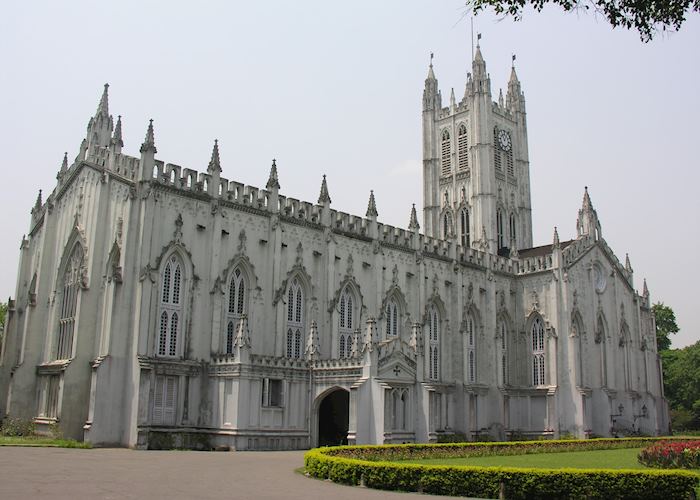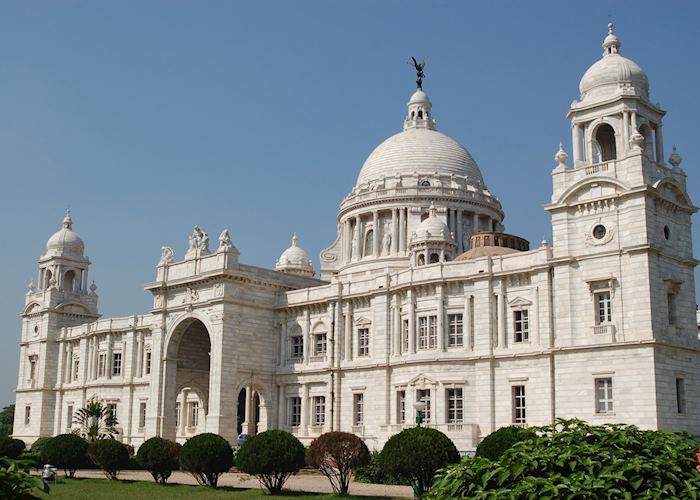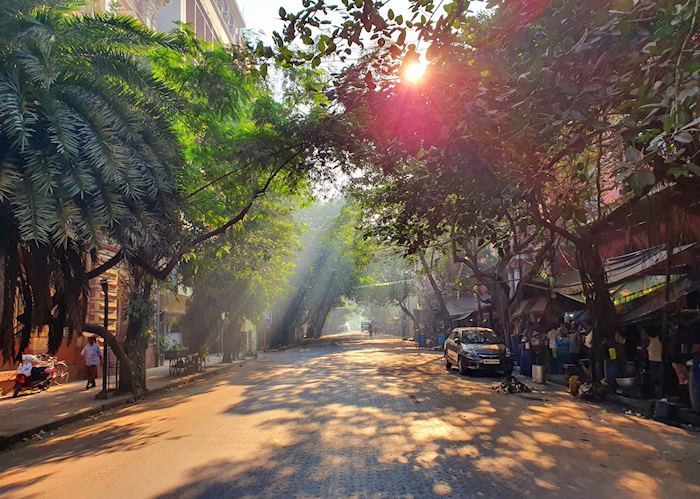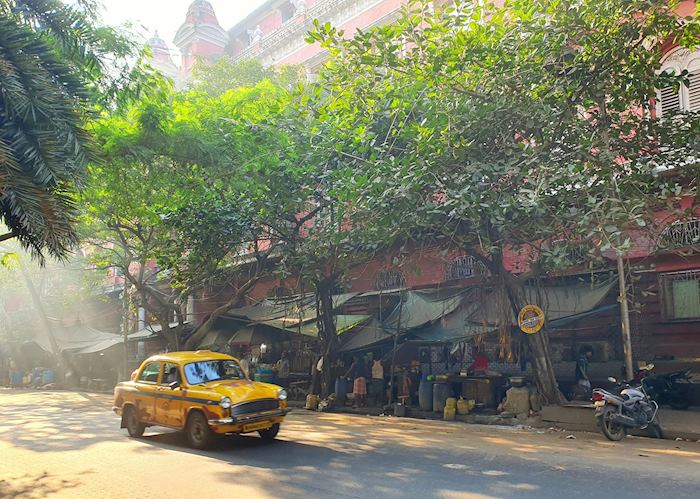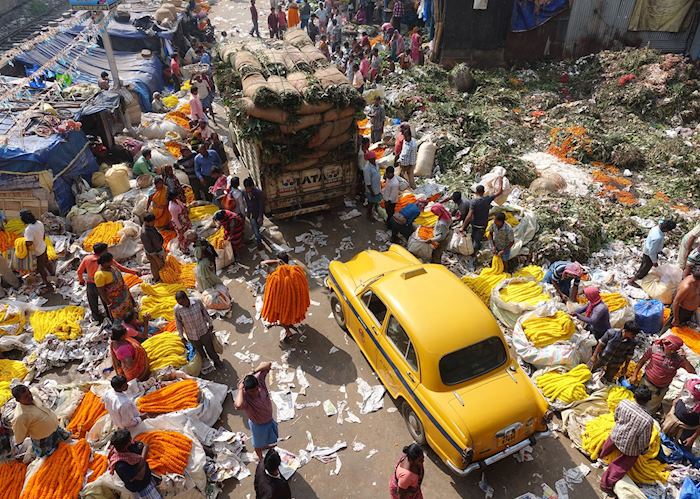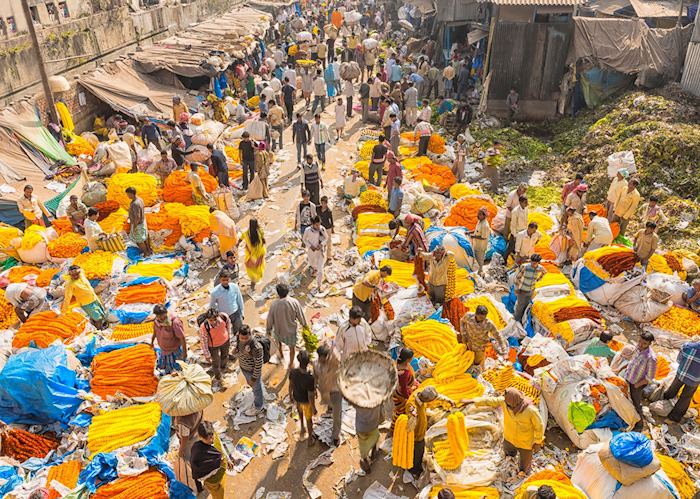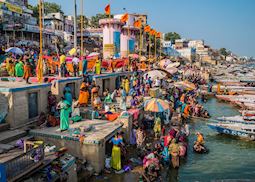Flower markets, imperious British colonial buildings, a medley of street food and the sacred Hugli River in West Bengal's capital city.
 Calcutta’s a chaotic patchwork of colonial architecture, vibrant festivities and garlands of marigolds, with the distinct scent of Bengali street food. However, India’s third largest city manages to organize this chaos while proudly showcasing its rich tapestry of history, art galleries, religion and culture.
Calcutta’s a chaotic patchwork of colonial architecture, vibrant festivities and garlands of marigolds, with the distinct scent of Bengali street food. However, India’s third largest city manages to organize this chaos while proudly showcasing its rich tapestry of history, art galleries, religion and culture.
Venture inside the city and you’ll be rewarded with the white-marbled Victoria Memorial, an 18th-century colonial graveyard and the cavernous flower market. You can explore the city’s contrasting areas on foot or cruise along the Hugli River — a tributary of the Ganges. Along its banks are ghats (a series of steps), where local residents float candles and floral offerings.
Alternatively, try a multi-day cruise into the relatively untrodden West Bengal or board a local ferry across the river to Howrah Station, the oldest and largest in India. From Calcutta, you can catch domestic flights onto Assam, Darjeeling or toward the Himalaya.
Calcutta on foot
It’s best to explore Calcutta’s streets early in the morning, when traffic is sparse. With a guide, venture into the Jewish or Portuguese quarters or stroll down College Street, lined with piles of university books. Alternatively, sample some Bengali morsels on a breakfast tour. Try mishti doi, a sweet fermented yogurt, washed down with tea served in a traditional clay pot made from the sacred Hugli’s clay.
You could also take a tour of the potter’s market, where clay is used to make larger-than-life-size statues of Indian gods which are decorated during festivals with garlands. Once they have been used, the statues are returned to the river, and the clay is recycled.
For those looking for an insight into Calcutta’s colonial history, we recommend a stroll through South Park Street Cemetery. The eclectic mix of 18th-century tombs and graves are cloaked in rugs of moss and shrouded by vegetation. It’s a tranquil oasis inside the bustle of the city.
Victoria Memorial
 This vast white-marbled building stands as a grand reminder of Calcutta’s colonial past. Built between 1906 and 1921, the Victoria Memorial commemorates the death of Queen Victoria via a symphony of Indian and British architectural designs. The building shelters a substantial collection of art and books, including the illustrated works of William Shakespeare, displayed throughout its 25 galleries.
This vast white-marbled building stands as a grand reminder of Calcutta’s colonial past. Built between 1906 and 1921, the Victoria Memorial commemorates the death of Queen Victoria via a symphony of Indian and British architectural designs. The building shelters a substantial collection of art and books, including the illustrated works of William Shakespeare, displayed throughout its 25 galleries.
Together with a driver and guide you can easily combine the Victoria Memorial with the nearby churches of St John and St Andrew. Allegedly, St Andrew’s spire was constructed against the Bishop of Calcutta’s orders, and built to be higher than the St John’s Neoclassical cathedral church, with a cockerel at the top to crow over the Bishop.
The flower market
Next to the Hugli River, the flower market begins to stir early in the morning as thousands of vendors and buyers flock under the Howrah Bridge. Again, we recommend a guided walking tour (it’s very easy to get lost) and the best time to visit is an hour after sunrise.
As you’re guided through the sprawling market, you’ll see garlands being made, bought and sold. Climbing through the market’s layers you can look down over groups of people sat in circles around thousands of giant piles of pink, crimson and orange marigolds hand-sewing them onto strings.
Each flower symbolizes a different religious or medical purpose in Indian life. The garlands are mainly used for ceremonial purposes — however some are used for temple offerings and puja (prayer). During festivals they’re used to decorate everything from houses and cars to sheep.
Hugli River multi-day cruising
Calcutta is a gateway for exploring the contrast between India’s industrial cities with agricultural practices and village deities. Onboard a multi-night cruise, you’ll float past mildewed warehouses and locals washing laundry in the ghats before immersing yourself in West Bengal’s relaxed pace of life. As the settlements diminish in size, you’ll find decorated riverside temples and a sprinkling of former Dutch, and French colonial settlements.
Best time to visit Calcutta
Calcutta’s best visited between October and March when warm days are paired with cool evenings. December and January bring cooler weather and some fog, which can affect internal flights. Between April and May, temperatures often rise over 104°F (40°C). This is followed by monsoon season, where the temperature drops, humidity rises and there are frequent showers — especially in August.
who's been there
Start planning your tailor-made trip to Calcutta by contacting one of our India specialists
- 617-223-4195
- Make an inquiry
Photos of Calcutta
Our expert guides to exploring Calcutta
Written by our specialists from their own experiences of visiting Calcutta, these guides will help you make the most of your time there. We share both our practical recommendations and the best ways to appreciate Calcutta at its best.
-
River cruises in India ![Varanasi, India]()
River cruises in India
River cruises in India
Take in the history, wildlife and culture of northeast India on a river cruise. Our India specialist Sarah shares some of her favorite things to see and do while cruising along the Brahmaputra, Ganges and Hugli rivers.
Read this guide



